For English version scroll down
Habíamos cogido el autobus de la compañía Egged la cual es una de las principales en Israel y podíamos comprobar los horarios en internet y como extra tenía internet gratuito dentro del autobús.
Llegamos a la hora prevista a Jerusalén y nada más salir del autobús tuvimos un control de equipajes. En la estación nos encontramos con un gran número de soldados y nos imaginamos que debería de ser por la situación de la semana pasada en la explanada de la mezquita.
A la salida de la estación se encuentra el tranvía, el cual nos dejaría al lado de nuestro hostal, en la entrada a la ciudad vieja, en la zona árabe al lado de la puerta de Damasco. Pero antes de irnos al alojamiento comimos algo rápido en la estación.
Para viajar en tranvía y autobús por Israel tienes dos opciones: comprar billete a billete o sacarte una tarjeta MAV, la cual te vale para los dos medios de transporte y es más barata. El único inconveniente es el de tener que ir a tramitarlo a una oficina del estado, y tienes que llevar una fotografía, copia del pasaporte, y rellenar el formulario. Como íbamos a estar caminando la mayor parte del tiempo, y tampoco nos apetecía ir a la oficina y perder el tiempo allí, pues fuimos comprando uno por uno.
El alojamiento en Israel es bastante caro para un presupuesto de mochilero como el nuestro, nosotros cogimos un hostal, que no tenía aire acondicionado, y que dejaba mucho que desear cuando lo vimos… Y nos costó 140 euros para las 4 noches. Pero todo lo demás escalaba a más de 200 euros y las condiciones o donde se encontraban no era de lo mejor. Así pues nos resignamos con lo que teníamos y que al fin y al cabo estaba al lado de la ciudad vieja. Una vez hecho el check in caminamos un poco por la zona sin alejarnos mucho ya que lo dedicamos a la “logística” para buscar como cruzar el borde entre Israel y Jordania y alojamiento en Amman. Para cenar fuimos a comer un Shawarma, (un kebab, pero si dices kebab te dan un pincho moruno), al lado del hostal.
Al día siguiente nos fuimos a ver la ciudad vieja por la mañana entramos por la puerta de Damasco y fuimos hasta la puerta de los Leones de camino se pueden ver alguna de las estaciones del vía crucis de Jesús. En nuestro caso fuimos esa mañana a ver la casa de nacimiento de la virgen Maria, sobre la cual se ha construido una basílica y las ruinas de Bethesda.
En la entrada, que nos costo 2.5 euros aproximadamente, nos encontramos que la monja que estaba vendiéndonos las entradas era de India, y empezamos a hablar un poco de su país, ya que le comentamos que lo íbamos a visitar el próximo mes. Un encanto de mujer.
Una vez dentro, primero fuimos a ver las ruinas, las cuales son un conglomerado de civilizaciones unas sobre otras; judías; romanas; bizantinas; cruzados. Nos metimos por todos los lugares posibles para poder observarlas con mayor detenimiento. Como el calor ya apretaba nos fuimos a la basílica para refugiarnos del Sol y poder continuar con la visita. Cuando entramos nos encontramos con la grata sorpresa de que un grupo de turistas alemanes estaban cantando unos salmos, y no lo hacían nada mal. Nos sentamos un rato hasta que acabaron y se fueron, para poder ver la iglesia sin molestarles. En el lateral de la iglesia se encuentran las escaleras que bajan a la casa de la virgen María. Aunque cuando bajas no ves casi nada original, parte de un muro y poco más.
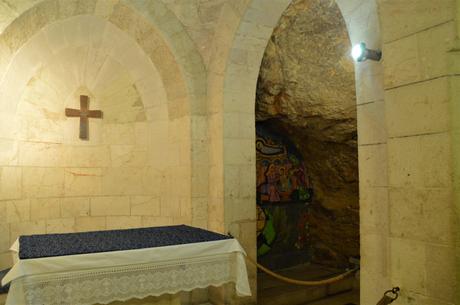
Lugar nacimiento Maria – Birthplace of Mary
Salimos con la idea de seguir el viacrucis, pudimos entrar en la iglesia donde coronaron a Jesús con la corona de espinos, pero después nos fuimos al hostal ya que Ale no se encontraba bien debido al calor. Así pues volvimos para descansar un poco.
Ya recuperada fuimos a comer algo, encontramos un sitio en la ciudad vieja donde servían uno de los mejores humus y allí nos fuimos. Si bien el humus y el falafel estaban muy buenos, el trato y la desgana del camarero dejó mucho que desear.
Nos dejamos perder un poco en las callejuelas de la ciudad vieja, mientras teníamos como objetivo ir a la iglesia del santo sepulcro. La cual es una combinación de un montón de iglesias en un gran edificio. Dentro de ella cada grupo cristiano: ortodoxos, católicos, armenios, griegos, franciscanos, sirios y etíopes tienen su propia parte. Unos donde fue crucificado, otros donde fue enterrado, otros donde se apoyo su cadáver, donde se encontró la lanza que le clavaron en el costado, etc. La convivencia con tantas ramas del cristianismo, dentro de la misma iglesia es un poco particular. Para hacer cualquier cambio todos tienen que estar de acuerdo, y la pregunta del millón ¿Es eso fácil? Pues mira la siguiente foto con esa escalera de mano, que está debajo de la ventana abierta.
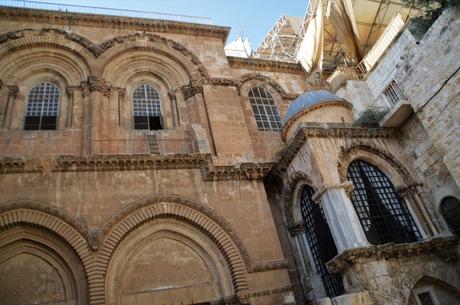
¿No parece muy nueva, no? Ni que estén haciendo reconstrucciones, verdad. Pues nada de eso, esa escalera lleva ahí nada más y nada menos que más de 300 años sin moverse porque no se ponen de acuerdo para mover una simple escalera. Parece ser que ninguno quiere poner la otra mejilla.
La iglesia se construyó en el lugar donde, según los evangelios, se produjo la crucifixión, enterramiento y resurrección de Cristo. El centro principal de la iglesia es el santo sepulcro, el cual se conoce como la rotonda.
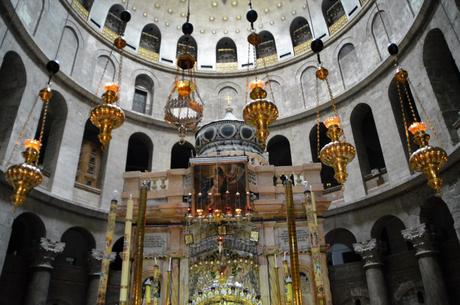
Santo sepulcro – Holy sepulchre
El interior de la iglesia(s) es soberbio y el fervor que puedes ver de algunos fieles tampoco te deja indiferente. Algunos se veían con las lágrimas en los ojos, otros con una cara petrificada ante lo que estaban viendo, otros impresionados con la simbología religiosa. Aunque también se puede ver mucho dominguero falto de respeto en general que igual te va a la playa en bañador como te visita un templo, o te va a la ópera vestidos de la misma forma. En este caso este último grupo se quedó con las ganas de ver parte de la iglesia, con el claro comentario de los curas/monjes de: “demasiado corto” o simplemente “demasiado, fuera”
Estuvimos dentro de la iglesia visitando todos los recovecos durante una hora, viendo el Golgota, (donde se produjo la crucifixión); la piedra de la deposición (donde el cuerpo fue preparado para ser enterrado); el santo sepulcro (al cual pudimos estar 10 segundos antes de que nos echaran por la cola que había); el lugar donde se habían encontrado las tres cruces (y se dice que una fue la de cristo, ya que produce milagros y las otras dos no); y un montón de diversas capillas cada una de una rama diferente del cristianismo.
Al salir de la iglesia nos fuimos a ver el muro de las lamentaciones, pero en lugar de ir directos fuimos dando un paseo por el barrio cristiano, pasando por la torre de David y el barrio armenio y obviamente el barrio judío. Desde el barrio judío hay un mirador desde el cual puedes ver el muro de las lamentaciones y la cúpula de la roca.
Debido a la tensión y eventos de las semanas anteriores a nuestra visita en la explanada de las mezquitas, decidimos no entrar en la misma, y visitamos sólo el muro de las lamentaciones. En este caso al llegar a la vista panorámica y ver las colas que había decidí disfrutar de la vista sin acercarme al muro, aunque Ale, bajo a ver el muro de cerca. Cómo el muro está dividido en dos partes para hombres y mujeres, Ale pudo evitar las largas colas que había en el de hombres y acercarse al mismo.
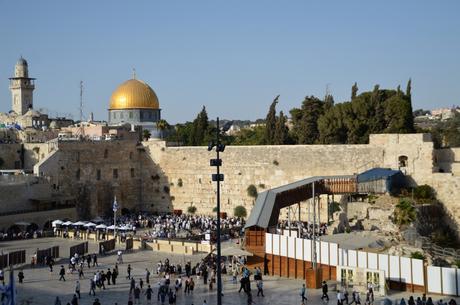
Muro de las lamentaciones – Wailing wall
Volviendo para nuestro hostal, salimos fuera de las murallas, donde puedes ver un poco la historia de la misma y las diferentes fases de construcción y partes que quedan de cada periodo. También fuera de las murallas y cerca de la puerta de Sion se puede encontrar la tumba del rey David y el lugar de la última cena de Jesús. Este último ya estaba cerrado así que nos fuimos ya para el hostal.
Al día siguiente teníamos la intención de ir a ver Masada, Ein Guedi y el mar muerto. En nuestro hostal nos ofrecían un tour para ver todos esos sitios, todos por el módico precio de 110 euros por persona sin incluir las entradas… y haciendo cálculos con transporte público y entradas nos salía por 100 euros para los dos, pues amablemente reclinamos la “generosa” oferta.
Para ir a Masada puedes ir fácilmente con los autobuses de la compañía Egged que te dejan en la base de la explanada de acceso desde el lado del funicular. Las líneas son las 486, 444 o 421 (este último no sale desde la estación de autobuses central). Una vez visitado cogeríamos otro autobús, 486,384 o 444, que nos dejaría en Ein Guedi, al lado del mar muerto. Y ya de vuelta otro autobús desde Ein Guedi, 486 o 444. Nosotros cogimos el autobús a primera hora para evitar el calor.
Cuando llegamos a la estación de autobuses fuimos a comprar los billetes, pero nos indicaron que se compraban en el autobús directamente, cuando por fin abrieron las puertas para acceder nos empezaron a decir que estaban llenos y que no había, a lo cual le contestamos que en taquilla nos dijeron que si y que se compraban en el autobús, después de que el conductor discutiera con otra persona que no sabemos quién era nos dijo que fuéramos al otro autobús, que estaba al lado que él no iba a Masada… Totalmente descolocados nos fuimos al otro con otra señora que estaba también un poco perdida con la situación. En el otro autobús nos dijeron que teníamos que comprar el ticket en la taquilla, volvimos a repetir lo mismo, pero el señor insistía. La señora empezó ya a hablar con mala leche y sorprendida por el esperpento de la situación en hebreo con el conductor y fuimos detrás de ella a comprar los billetes. La persona que nos atendió a primera hora no estaba por suerte para ella porque le hubiéramos cantado las cuarenta, compramos el billete y volvimos al último autobús, donde nos dijo el conductor que el que iba era el otro autobús. La señora, como nosotros, desesperada por lo ridículo de la situación, subió el tono con el conductor, no sabemos lo que le dijo, pero nos mandaron al primer autobús de vuelta, que originalmente no iba a Masada y ahora milagrosamente iba. Si no es por casualidad que en esta tierra se produzcan tantos milagros. La señora nos comentó que esta es la primera vez que le paso algo tan absurdo como lo vivido. Viva nuestra suerte 🙂
El autobús llegó a tiempo y fuimos a comprar la entrada a la fortaleza, en un principio quería subir por el camino llamado, de la serpiente. Pero el guardia nos dijo que estaba cerrado y que teníamos que ir por el teleférico. Así pues subimos todo el camino hasta el edificio del teleférico para comprar el billete de entrada y de paso volver a preguntar. No es que no me fiara, pero prefería comprobarlo. En la taquilla nos confirmaron que estaba cerrado por riesgo de calor extremo, pero si no son ni las 10 de la mañana. Cuando salimos fuera del edificio el calor nos volvió a la realidad. No me imaginaba al equipo de médicos subiendo los 400 metros que separaban la base de lo alto de la fortaleza para atender a la gente que le diera algo en la subida por el calor y que al mismo tiempo no le dieran a ellos.
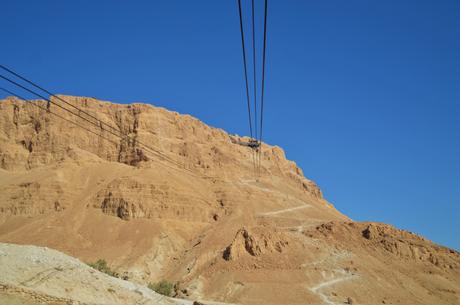
Camino a Masada – Way to Masada
Según vas subiendo por el teleférico empiezas a tener una vista general de la extensión del mar muerto y de la región que domina la fortaleza, a medidas que subes se puede observar los restos del campamento romano y de la fortaleza que construyeron alrededor durante el asedio que se llevó acabo durante la primera guerra judea romana.
Nada más subir fuimos a ver la zona izquierda donde apenas existe sombra y no hay apenas construcciones en pie. Lo más interesante de esta zona además de las vistas que ves alrededor de la fortaleza, es la cisterna de agua que se encuentra en esta parte de la fortaleza. Según desciende en ella te das cuenta de la cantidad de agua que podía contener, dentro de la misma te sientes empequeñecido con el tamaño de la misma. Se pueden ver aún los aislamientos que se crearon para que el agua no se filtrara, aunque por desgracia varias personas decidieron que dejar su nombre es más importante que esa capa de aislamiento e hicieron grafitis rascando la protección. Al menos hubo uno simpático que si eres un fan de la vida de Brian y puesto en el contexto de la fortaleza te hace reír, estaba escrito “Romanus ite domum” Sigue siendo un acto de vandalismo, y de vulgaridad extrema escribir en restos históricos, pero, sin llegar a defenderlo, al menos fue más simpático que Fulano y Fulana estuvieron aquí en el año de la patata.
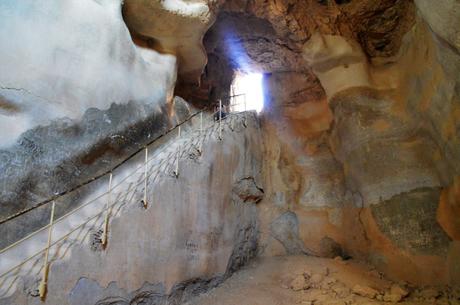
Cisterna de agua – Water cistern
Según continuas por el borde de la montaña, puedes observar la rampa que los romanos construyeron para conquistar el asedio y el punto por donde la torre de asalto rompió el muro. Un trabajo impresionante de asedio militar, viendo la cantidad de piedras y tierra que debió ser movida para la construcción del mismo, mientras estaban siendo atacados por los defensores en lo alto. En la otra punta de la fortaleza se encuentra la mejor parte conservada de la fortaleza con restos del palacio, las termas (con el calor que hacía nadie necesitaba unas en esas condiciones), los graneros, los puestos del jefe de guardia. En varias partes se pueden encontrar maquetas donde se reproducen las construcciones originales y lo más interesante es el sistema de acueductos que transportaban el agua para mantener tamaña fortaleza abastecida en el medio del desierto. Cuando acabamos la visita era casi la 13:00 y el calor era tal que no se podía estar ya fuera. Así pues con pena de perdernos el mar muerto y Ein Guedi, decidimos volver a casa y así evitar que nos diera algo con tanta calor. Comimos algo en el centro de Masada y después nos fuimos a coger el autobús de vuelta a Jerusalén.
Por la noche fuimos a cenar a un restaurante cerca de las murallas viejas, en la barriada de los artistas, y resultó ser la mejor experiencia gastronómica que hubiéramos tenido nunca. No sólo por la cantidad, sino especialmente por la cualidad del producto y la posibilidad de hablar con el chef. Sin conocer el sitio para nada, lo encontramos por casualidad en una app y fuimos a verlo. Según entramos el trato fue exquisito y muy amable, como no sabíamos que comer nos ofrecieron la posibilidad de tener uno de los menús de degustación que incluye varios platos del menú. Dentro de los tres menús que existían de degustación cogimos el más sencillo, por sencillo léase que eran más de 14 platos para degustar incluyendo postre, cosa que no sabíamos al principio. Lo primero empezamos con unos entrantes trayéndonos un pan recién hecho con tres salsas para mojar, no sé lo que tendrían pero cada cual estaba mejor que la anterior, después tres “chupitos” de sopa servidos en vasos de café expreso, ¡gloriosos! La comida seguía llegando y nosotros cada vez más llenos pero disfrutando de cada plato aún más que el anterior, que si higos rellenos con carne de pollo, que si cordero cocido en su salsa en un plato de barro y tapado con pan, que si falafel de pescado, que si achicoria rellena de ternera, etc.. Los camareros de vez en cuando preguntándonos que tal íbamos y nosotros bien está todo riquísimo, pensando que nos iban a traer ya los postres y no seguían trayendo más platos principales, hasta que ya se nos debía notar que no podíamos más y el camarero nos preguntó si queríamos los postres ya. Ya llegados a ese punto y llenos pues si venga tráelos que unas cuantas calorías más no nos iba a matar. Ya cebados nos fuimos rodando como pudimos para el hostal.
El último día lo dedicamos a ver la zona de los museos de Jerusalén, fuimos caminando desde el casco viejo hasta la parte nueva. Por el camino se veían los preparativos para la marcha gay que se celebraba esa tarde y a lo cual nos queríamos pasar por ella.
Entre que salimos tarde y el paseo pues llegamos sobre las 10:30 a los museos. Dentro del recinto se encuentran, una zona dedicada a los rollos del mar muerto, otra a una maqueta de Jerusalén antes de que fuera destruida en la primera guerra judea-romana, un museo de arqueología, otro de bellas artes, y varios espacios para exhibiciones temporales, jardines, salas de reproducciones. Vamos que nos íbamos a pasar todo el día entretenido dentro del mismo.
Con la entrada al museo te dan una audioguia que complementa a los carteles informativos que ya existen. Como teníamos ya varias experiencias de estar debajo del Sol con el calorcillo que hacía pues nos fuimos a ver primero la graaaaaan maqueta, la cual tenía más de 40 minutos de audioguía… Muy interesante en general ver como era toda la ciudad y ver la grandiosidad de aquella época. La siguiente sala que fuimos a ver fue la de los rollos del mar muerto, la cual está construida en forma de anfora y dentro de la misma las copias de los rollos se exponen imitando un gigantesco rollo. La siguiente gran sección era la de arqueología, aunque empezamos bien, enseguida no sabíamos que orden seguir de un lado para otro así que nos perdimos un poco en el orden, pero viendo todo finalmente. Como no nos quedaba mucho tiempo para el cierre, fuimos a ver la exhibicion temporal de Ai Weiwei y hacer una pasada rápida a otra temporal de arte contemporaneo.
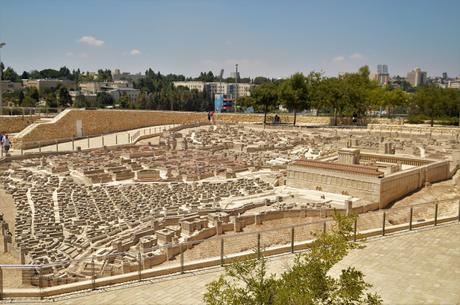
Maqueta de Jerusalén antes de la destrucción del templo – Jerusalems scale model before the temple destruction
Ya cerrado volvimos de nuevo caminando para pasear por la zona cerca de la calle de Yaffo y de paso aprovechar para comer uno de los mejores Shakshukas de Jerusalén en Tmol Shilshom cafe, y después unirnos a la marcha que pasaba cerca de la zona. El problema que tuvimos es que toda la zona estaba vallada, aquí la seguridad se lleva a tope, y no pudimos pasar, así que nos quedamos como meros observadores. Acabado nos fuimos a empaquetar las cosas y a dormir ya que al día siguiente nos íbamos al siguiente país Jordania.
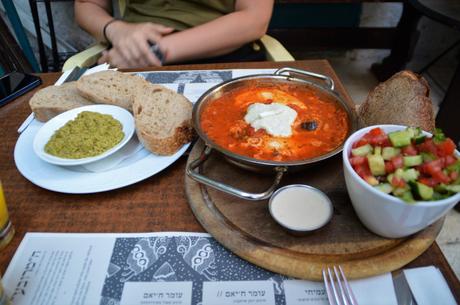
Shakshuka
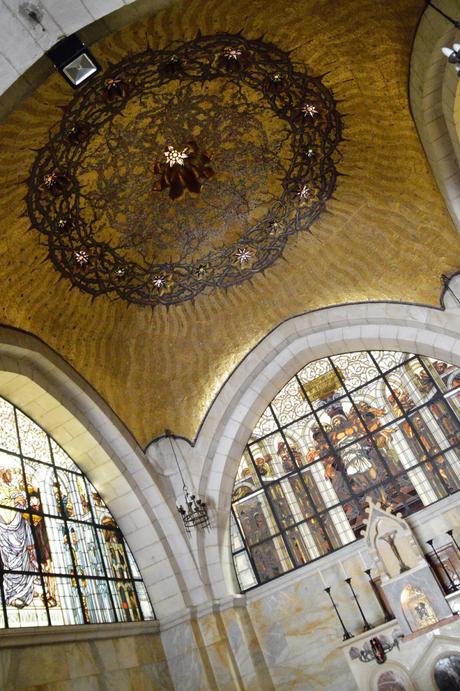
Capilla de la primera estacion – First station chapel
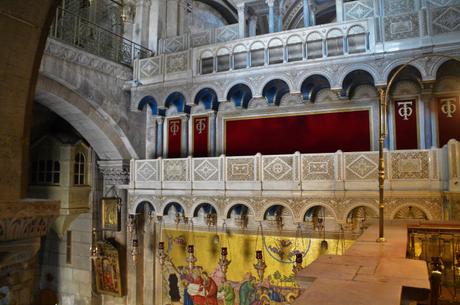
Desde Golgota – From Golgota
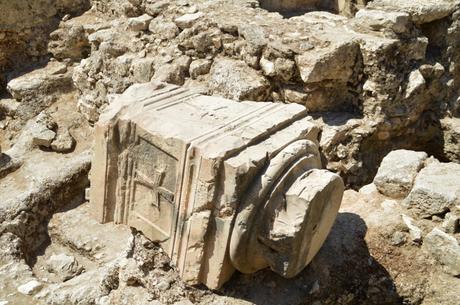
Ruinas en Bethesda – Ruins from Bethesda
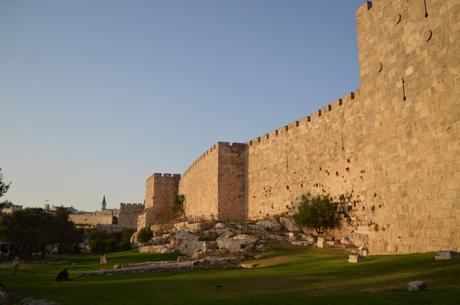
Murallas de Jerusalén – Jerusalem walls

Mosaicos del palacio en Masada – Mosaics from the palace in Masada
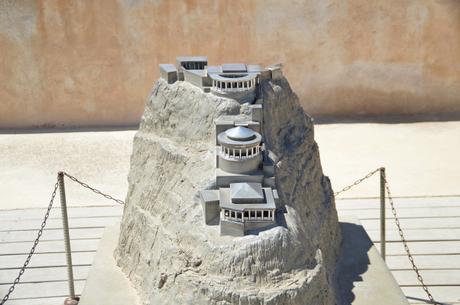
Maqueta del palacio – Scale model of the palace

Ruinas actuales del palacio – Present ruins of the palace
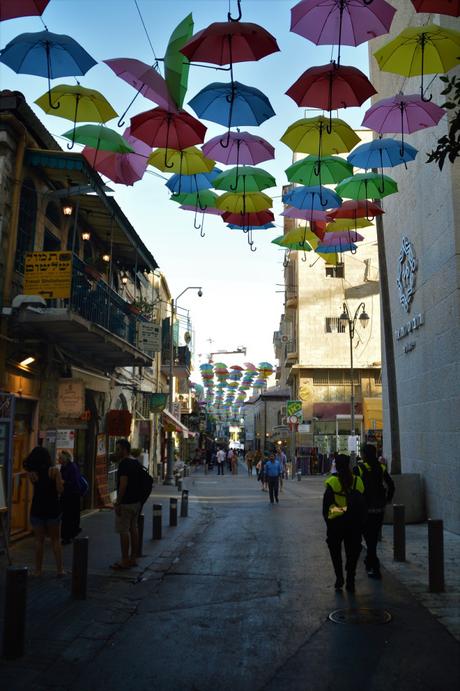
Paseando por la ciudad nueva – Walking in the new city
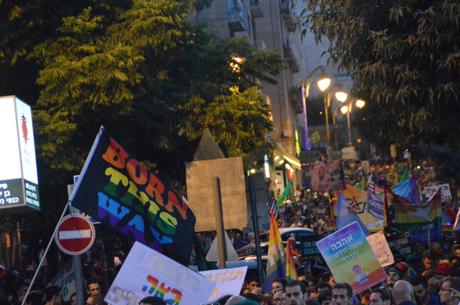
Manifestación – Demostration
We took the Egged bus, which is one of the main bus companies in Israel, since we could check the schedule online and it had as well free wifi inside the bus.
We arrived on time to Jerusalem and as soon as we went out of the bus, we went through a luggage check. There were many soldiers in the bus station and we imagined that the reason were the events from the Temple Mount, that had taken place the previous week.
The tram stop is right in front of the bus station exit; the tram was supposed to let us right by our hostel, at one of the entrances to the old city, in the Muslim area close to the Damascus gate. But before going there, we ate something quickly in the bus station.
In order to travel by tram and bus in Israel, you have two options: buying ticket by ticket or ask for a MAV card, which can be used for both means of transportation and is cheaper. The only inconvenient about this card is that you need to go to a state office and ask for it, you need a photo, a copy of your passport and fill in the form. Since we were planning to walk most of the time and we didn´t really want to spend time going to the office, we bought the tickets one by one.
The accommodation in Israel is quite expensive for a backpacker´s budget, such as ours, so we chose a hostel that did not have air conditioning and that didn´t make the best impression when we saw it… And it cost us 140 euros for 4 nights. The other options were going over 200 euros and the conditions or location were not the best. So we just settled for what we had and we were glad that it was close to the old city. After we did the check in we walked a bit in the area, without getting too far, since we were dedicating the rest of the day to the “logistics”, searching for the best way to cross the border between Israel and Jordan and for accommodation in Amman. We had a Shawarma for dinner (a kebab, but if you ask for a kebab in Israel, they will give you a skewer), close to the hostel.
The next day in the morning we went to see the old city, we went in through the Damascus gate and walked until the Lions gate, and on the way we could see a few stations of Jesus´ Via Dolorosa. That morning, we went to see the house where Virgin Mary had been born, on top of which a basilica was built and the ruins of Bethesda.
At the entrance, which cost us 2.5 euros (more or less), we met a nun that was selling the tickets and was from India, so we started to talk a bit about her country, since we told her that we were going there the following month. A charming woman!
Once inside, we went to see the ruins, which are a conglomerate of civilizations, one on top of the other: Jewish, Roman, Byzantine and from the Crusaders´time. We went everywhere, trying to observe them more in detail. Since the heat was already suffocating, we went to the basilica to hide from the sun and be able to continue the visit. When we went in, we were surprised to see that a group of German tourists were singing the Psalms and they were not bad at all at it. We sat a bit until the finished and left, so that we could see the church without bothering them. On one side of the church there were the stairs leading to Virgin Mary´s house. However, when you go down you don´t see much of the original building, a part of a wall and just a bit more.
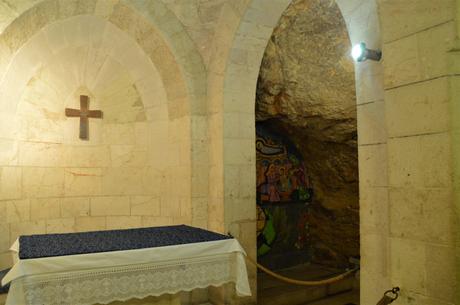
Lugar nacimiento Maria – Birthplace of Mary
We went out thinking to continue the Via Dolorosa, we went in to the church where they had put the crown of thorns on Jesus´head, but we had to go back to the hostel due to the fact that Ale was not feeling well because of the heat. So we went back to rest a bit.
Feeling better, we went to eat something – we found a place in the old city where they were allegedly serving the best hummus, so we went there. If the hummus and the falafel were very good, there is a lot of space for improvement for the customer service and interest of the waiter.
We let ourselves get lost on the small streets of the old city, while having the objective to go to the Church of the Holy Sepulchre. This church is a combination of more churches in one big building. Inside, each Christian group- Catholics, Orthodox, Armenians, Greeks, Franciscans, Syriacs and Ethiopians- has its own part. Some where He was crucified, others where He was buried, others where His body was laid after it was taken off the cross, others where the spear that stabbed Him in the ribs was found etc. The coexistence of so many branches of Christianity in the same church is a bit special. For any type of change, they all have to agree and the one million question is : “Is it easy?”. Well, look at the photo with this ladder, that is under the open window.
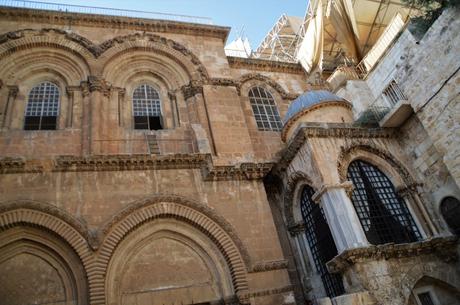
It doesn´t look too new, isn´t it? Nor are they renovating the building. Well, that ladder has been there for no less than 300 years without moving, because they cannot agree to move a simple ladder. It seems that none of the groups wants to turn the other cheek.
The church is built on the place where, according to the Bible, Jesus Christ´s crucifixion, burial and resurrection took place. The main part of the church is the Holy Sepulchre, known as well as the Rotunda.
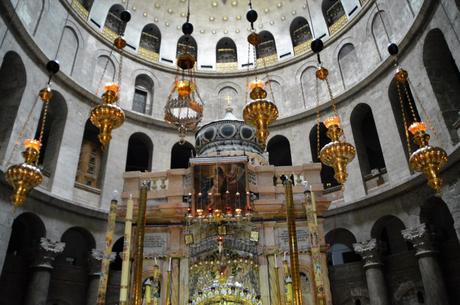
Santo sepulcro – Holy sepulchre
The interior of the church(es) is beautiful and the fervor of some believers does touch you. Some of them had tears in their eyes, some were petrified by what they were seeing, others impressed by the religious symbols. Unfortunately, you can also see there the “day tripper”, that have no respect in general and that go to a temple or to the opera dressed in the same way as they go to the beach. In this case, this group did not see part of the church, receiving clear comments from the monks: “too short” or simply “enough, go out”.
We were inside the church visiting all the sites for one hour, seeing Golgota (where the crucifixion took place); the Stone of Unction, (where the body was prepared for burial); the Holy Sepulchre (where we could stay for 10 seconds before we were asked to go out due to the huge queue); the place where there were the three crosses ( it is said that one was Jesus Christ´s, since it makes miracles and the other two do not); and many other chapels belonging to the different branches of Christianity.
When we went out of the church we went to see the Wailing Wall, but instead of going directly, we went for a walk through the Christian quarter, passing by the tower of David, the Armenian quarter and obviously the Jewish quarter. In the Jewish quarter there is a viewpoint from where you can see the Wailing Wall and the Dome of the Rock.

Muro de las lamentaciones – Wailing wall
Due to the tensions and the events that took place in the previous weeks, we decided not to go inside the Dome, so we just visited the Wailing Wall. Getting to the viewpoint and seeing the queues to go in, I decided to enjoy the view without getting closer, although Ale went down to see the wall from close. Since the wall is divided into two sides, one for men and one for women,Ale could avoid the huge queues on the men side and get closer to the wall.
On the way back to our hostel, we went out of the old city, walking around the walls, where you can see a bit of history and the different phases of construction from each era. As well, outside the walls and close to the Sion gate there is the tomb of King David and the place of the Last Supper. The latter was already closed, so we went to the hostel.
Our plan for the next day was to see Masada, Ein Gedi and the Dead Sea. Our hostel was offering a tour for all these places, for the “low” price of 110 euros per person, without including the entrance fees… after calculating the price of the public transport and the entrance fees, the total was 100 euros for the both of us, so we kindly declined the “generous” offer.
In order to get to Masada, you can easily take one of the Egged buses, which drops you close to the entrance next to the funicular. The bus lines are 486, 444 or 421 (this last one does not leave from the central bus station). After the visit, we would take other buses, 486, 384 or 444, that would leave us at Ein Gedi, close to the Dead Sea. In order to go back from Ein Gedi, bus 486 or 444. We took the bus first thing in the morning to avoid the heat.
When we arrived to the bus station, we went to buy the tickets, but we were told that we should buy them directly in the bus; when the doors were finally open and we were allowed to go into the bus, we were told that the buses were full, that there were no tickets, so we told them the person from the ticket counter told us that we could buy them in the bus. After the bus driver started to talk to another person, he told us that we should take the other bus and that he was not going to Masada… Totally confused, we went to the other bus with another lady that was as well a bit lost in this whole situation. In the other bus, they told us that we had to buy the tickets from the counter, we told him the same, but he kept insisting. The lady started to talk in Hebrew with the driver, already annoyed and surprised by this mess, so we followed her to the counter to buy the tickets. The person that was there in the morning was not the same that sold us the tickets, luckily for her, so we went back to the last bus, where the driver told us that the other bus was going to Masada. The lady was as desperate as us, and she raised her voice when talking to the driver – we don´t know what she told him, but they sent us to the first bus, which was not originally going to Masada and now it was, by some sort of miracle. It´s not by chance that there are many miracles in this area. The lady told us that this was the first time she had experienced something so absurd. Lucky us! 🙂
The bus arrived on time to Masada and we went to buy the tickets for the fortress; I initially wanted to hike all the way up on what they call the “snake path”. Unfortunately, the guard told us that it was closed and that we had to take the funicular. So we went all the way up to the building to buy the tickets and to ask again about the path. It´s not that I didn´t trust him, but I wanted to check. At the ticket counter they told us that the path was closed due to the extreme heat, even if it wasn´t even 10 in the morning. When we went out of the building, the heat brought us back to reality. I couldn´t imagine the paramedics going up the hill at 400 meters to take care of the people that would faint on the way up due to the heat, without being themselves victims of the high temperatures.
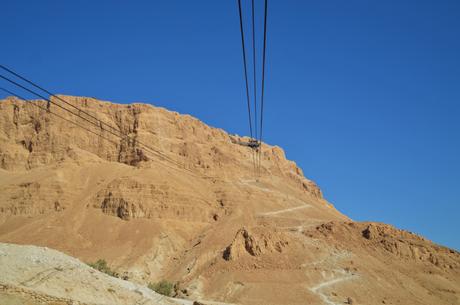
Camino a Masada – Way to Masada
From the funicular, you can get an idea of the size of the Dead Sea and the region that is dominated by the fortress, you can observe the ruins of the Roman camps and fortress that they built around them during the siege that ended during the first Jewish-Roman war.
Immediately after going up, we went to the see the left side where there is almost no shade and no standing buildings. The most interesting thing in this area, besides the views around the fortress, is the water cistern that can be found in this part of the fortress. As soon as you go down the stairs, you realize what was the quantity of water that it could contain and you feel small in comparison to its size. You can still see the isolation they used to prevent the water infiltration, although, unfortunately, some people decided that it was more important to leave their names there than the actual insulation layer and they made graffiti that scratched the protection layer. Well, at least one of the graffiti was funny in the context of the fortress and you would understand it only if you are a fan of “Life of Brian”: “Romanus ite domum”. It is still an act of vandalism to write things on historical ruins, but, without defending it, it was at least better than Mr and Mrs So-and-so were here before the flood.
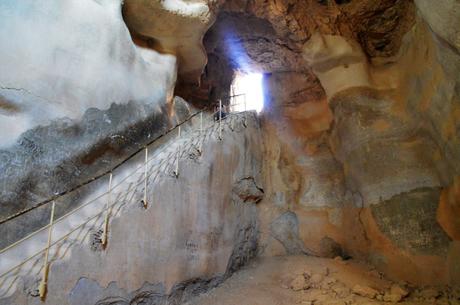
Cisterna de agua – Water cistern
If you continue on the edge of the mountain, you can see the rampart that the Romans built to finish the siege and the place where the assault tower broke the wall. This was an impressive military assault, seeing the quantity of stones and the ground that had to be moved for the construction, meanwhile they were attacked by the defense line from the fortress. On the opposite side of the fortress you can see the best kept part, with the ruins of the palace, the thermas (although with that heat, nobody needed one), the granary, the post of the Chief of the guards. In some places you can find scale models of the original constructions and the most interesting part is the aqueduct system, which was transporting the water for such a fortress, in the middle of the desert. When we finished our visit, it was almost 1 pm, and the heat was so strong that we couldn´t be outside. Unfortunately, we had to miss the Dead Sea and Ein Gedi and we decided to go back and avoid feeling ill because of the heat. We ate something at the cafeteria in Masada and we went to pick up the bus to Jerusalem.
In the evening we had dinner in a restaurant close to the old city walls, in the area of the artists, and it turned up to be the best culinary experience we ever had. This was not due to the quantity, but the quality of the food and the possibility to talk to the chef. We didn´t know the place at all, we found it by chance on an app and we went to check it. As soon as we went in, the staff was very nice and due to the fact that we had no clue what to eat, they offered us the possibility to have a tasting menu, which includes several dishes from their normal menu. From the three tasting menus they had, we chose the most simple – by simple I mean more than 14 courses, including the dessert, something we did not know in the beginning. The first thing we tried were the starters, they brought us fresh bread with three dips – I am not sure what they were, but each one was better than the other, after this, three “shots” of soup, brought to us in espresso cups, glorious! The food kept coming and we were getting full, but we were still enjoying each dish more than the previous one – figs filled with chicken, lamb cooked in its sauce in a clay pot covered with bread, fish falafel, artichokes filled with beef etc… The waiters were asking us from time to time if everything was ok, we were saying, yes, everything is delicious, thinking that they were bringing the dessert instead of main dishes, until I guess they noticed that we were quite full and asked if they could bring the dessert. If we had already reached this point, sure, bring it, a few more calories won´t kill us. We were so full that we could have just rolled down until the hostel.
We dedicated the last day to the museum area in Jerusalem, we went walking from the old city to the new area. We could see on the way the preparations for the Pride Parade that was taking place that evening and that we wanted to see as well. Due to the fact that we went out late and the long walk, we arrived at the museums at 10:30. Inside this complex you can find an area dedicated to the Dead Sea scrolls, one to the greaaaat scale model of Jerusalem in the First Temple era, an Archaeology museum, an Art museum and several spaces for temporary exhibitions, gardens, an auditorium. We realized that we would spend the whole day inside. In the price of the entrance ticket they include an audio guide that is an extra to the information boards in the museum. Since we had some experience being outside in the sun at the worst time of the day, we went first to see the biiiiig scale model, which had more than 40 minutes of explanations on the audio guide… It was interesting to see how the city looked by that time and see the grandiosity of that era. The next part we saw was the one of the scrolls, which is built in the shape of an amphora and inside, the copies of the scrolls are arranged in such a way that they look like a huge scroll. The next big section was the archaeological one – even if we started well, we got a bit lost in following the right order, but in the end we saw everything. Since we did not have too much time before the closing time, we went to see the temporary exhibition of Ai Weiwei and passed by another contemporary art exhibition quite fast.
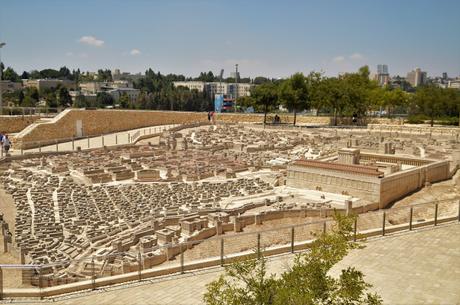
Maqueta de Jerusalén antes de la destrucción del templo – Jerusalems scale model before the temple destruction
We went for a walk on the streets around Yaffo and since we were there, we took advantage and went to eat one of the best Shakshukas in Jerusalem, in the Tmol Shilshom cafe, and then we went to watch the march, that was passing by that area. The problem we had was that the area was protected with fences and we could not get close to the people that were marching. Here the security is taken very seriously, so we had to settle to being observers. After this, we went to pack our bags, since the following day we were crossing to our next destination, Jordan.
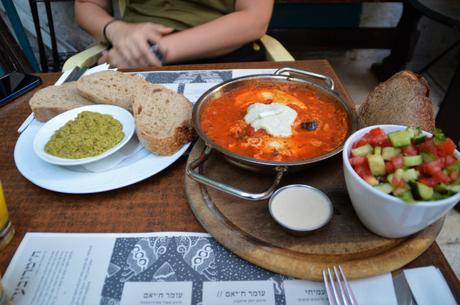
Shakshuka
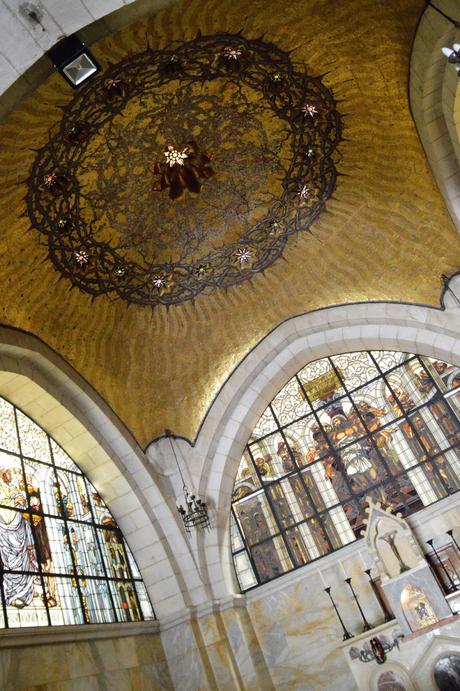
Capilla de la primera estacion – First station chapel
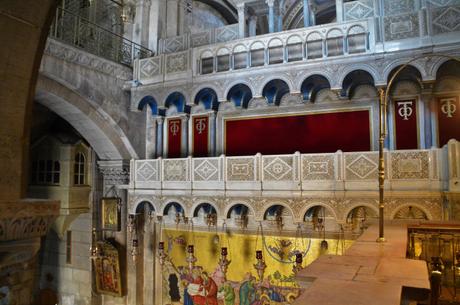
Desde Golgota – From Golgota
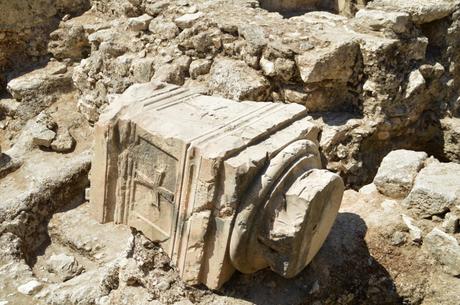
Ruinas en Bethesda – Ruins from Bethesda
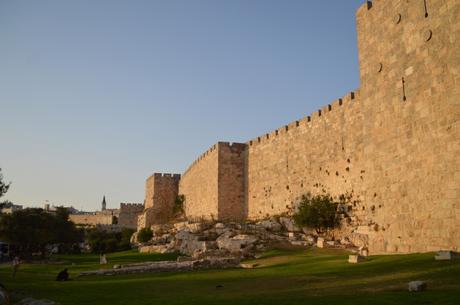
Murallas de Jerusalén – Jerusalem walls
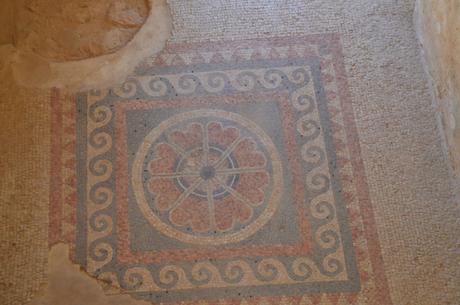
Mosaicos del palacio de Masada – Mosaics from the palace in Masada
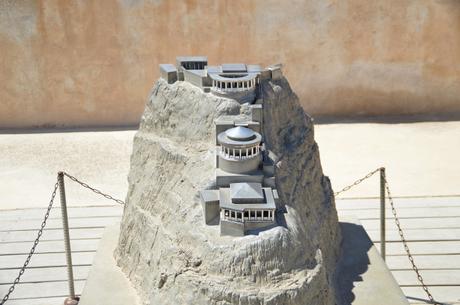
Maqueta del palacio – Scale model of the palace
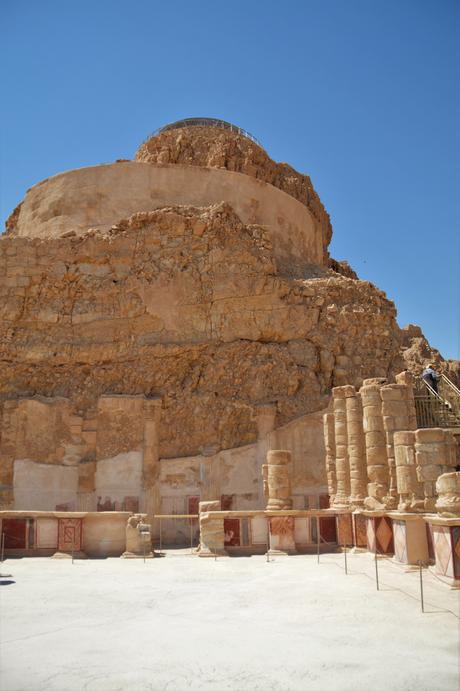
Ruinas actuales del palacio – Present ruins of the palace
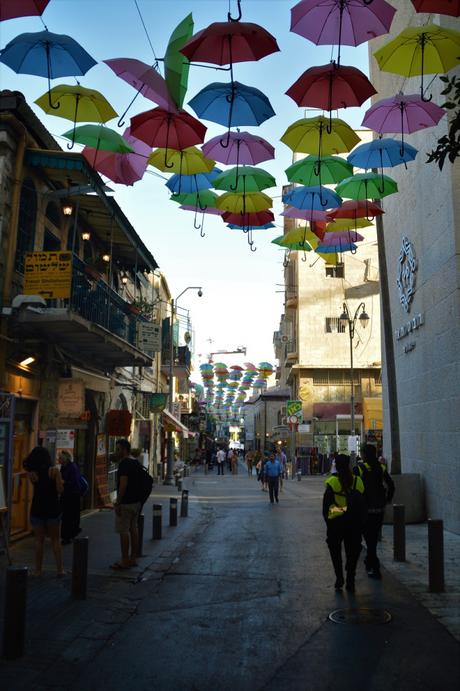
Paseando por la ciudad nueva – Walking in the new city
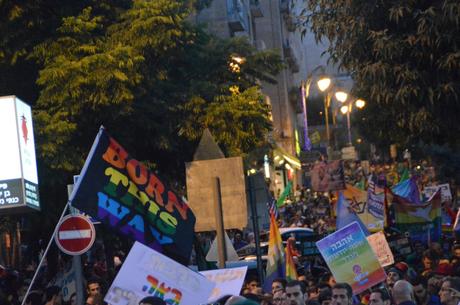
Manifestación – Demostration
Anuncios